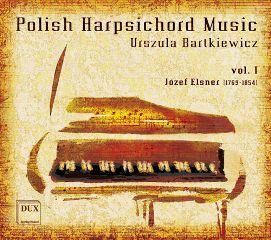Józef Elsner – Polish Harpsichord Music Vol.1 (Urszula Bartkiewicz) [2009]
Józef Elsner – Polish Harpsichord Music Vol.1 (Urszula Bartkiewicz) [2009]

Sonata II,1805 nr 3 D-dur 1 I. Allegro 7:19 2 II. Andantino. Allegro. Andantino. Allegro 4:35 Sonata III, 1805 nr 6 F-dur 3 I. Allegro 5:54 4 II. Larghetto 1:43 5 III. Rondo Allegretto 3:38 Sonata, 1805 nr 1 B-dur 6 I. Allegro 6:09 7 II. Adagio 2:34 8 III. Rondo Allegretto 3:26 9 Polonez, 1805 nr 11 B-dur 3:47 10 Polonez, 1805, nr 12 B-dur 3:43 11 Polonez, 1805 nr 11 d-moll 3:13 12 Polonez, 1805 nr 7 Es-dur 3:53 13 Polonez, 1805 nr 12 Es-dur 3:16 14 Polonez , 1805 nr 5 C-dur 3:40 15 Polonez, 1805 nr 7 C-dur 4:13 16 Rondo a la mazurek, 1803 nr 11 C-dur 2:42 17 Rondo a la krakowiak, 1803 nr 5 B-dur 3:41 Urszula Bartkiewicz – harpsichord
It's not at all clear whether this release delivers the promised Polish harpsichord music, but the music contained herein is nonetheless interesting. Composer Józef Elsner was born in 1769, and the sonatas and dances on the program come from a pair of publications that appeared in 1803 and 1805. Harpsichordist Urszula Bartkiewicz argues in her own notes (in Polish and English) that either a harpsichord or a piano might have been used for this music, but she cites no evidence that a harpsichord would have been a common choice for ambitious works like the sonatas here at this late date. She does mention a publication of some songs that may be accompanied by either clavichord or guitar, but this has limited relevance to the harpsichord/fortepiano question. The stylistic point of reference for the sonatas is, as Bartkiewicz points out, the world of Mozart and Haydn, but they contain some bravura passages that might have been products of the following generation of keyboard composers. At times the effect is like hearing Beethoven, or at least Clementi, played on Bartkiewicz's mighty French harpsichord. None of which is to say that the virtually unknown music of Elsner isn't worth hearing. It has a distinctively Polish tinge. The Allegro movements of the sonatas tend to be episodic, and the concluding rondos of the Sonata in F major and Sonata in B major introduce very dancelike episodes. Most interesting of all are the pieces marked "Polonez" (tracks 9-15) -- the ancestors of Chopin's Polonaises. These, modest in their technical demands and presumably oriented toward the home market, actually sound more suited to the harpsichord. They are mostly multi-strain pieces with a final return of the initial theme, and they make attractive use of the ambiguities of the polonaise rhythm, which perhaps explains why Chopin wrote polonaises but not krakowiaks, an example of which is also included here (along with a "mazurek"). These are simple but distinctive pieces that for many listeners will fill in a large blank page in the history of the origins of nineteenth century genres. The album as a whole opens up an intriguing repertoire even if one wishes to hear the music played on a fortepiano. --- James Manheim, Rovi
download (mp3 @320 kbs):
yandex 4shared mega mediafire cloudmailru uplea
